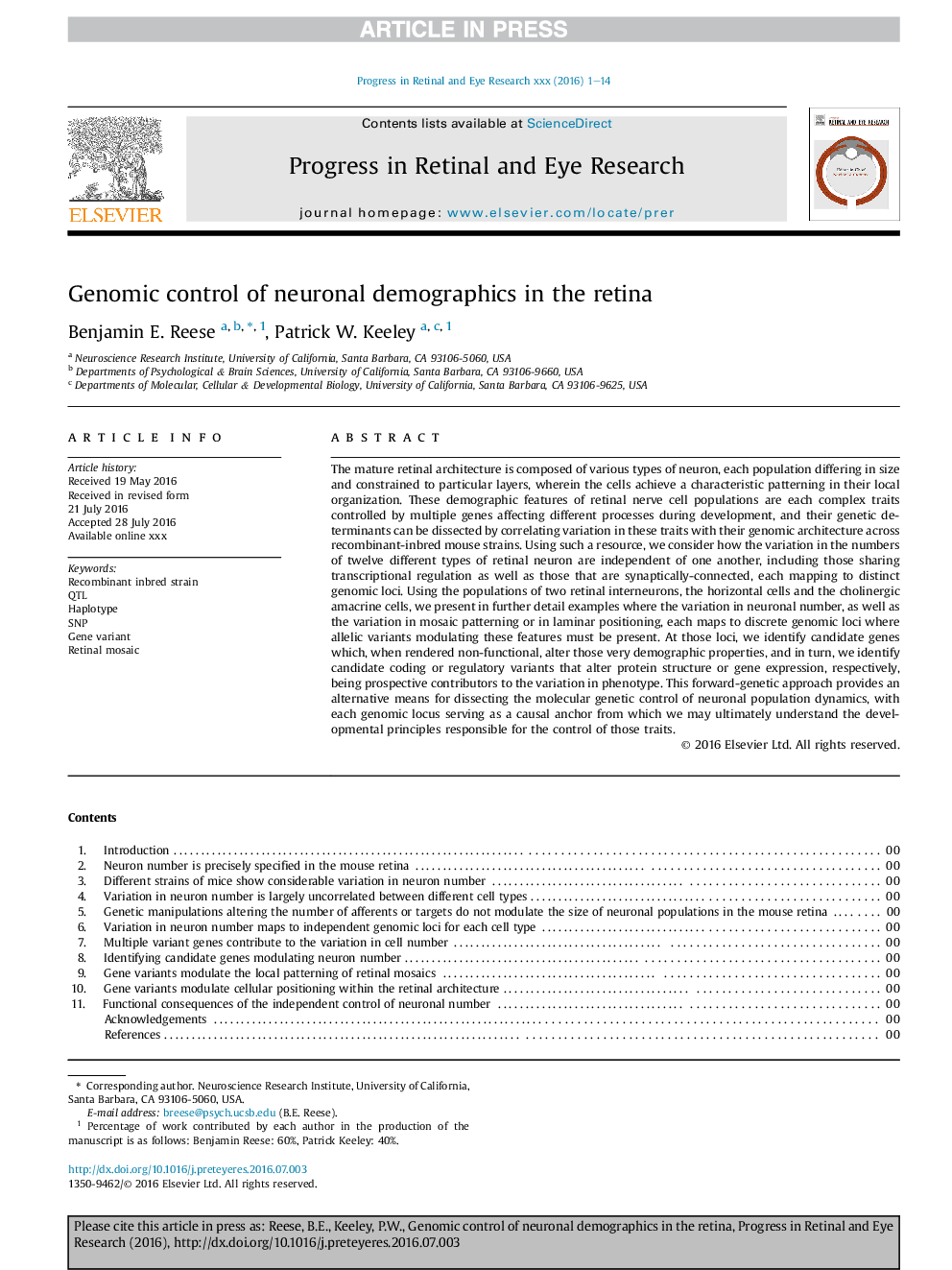| کد مقاله | کد نشریه | سال انتشار | مقاله انگلیسی | نسخه تمام متن |
|---|---|---|---|---|
| 5705671 | 1602811 | 2016 | 14 صفحه PDF | دانلود رایگان |
عنوان انگلیسی مقاله ISI
Genomic control of neuronal demographics in the retina
ترجمه فارسی عنوان
کنترل ژنومی جمعیت شناسی عصبی در شبکیه
دانلود مقاله + سفارش ترجمه
دانلود مقاله ISI انگلیسی
رایگان برای ایرانیان
کلمات کلیدی
ترجمه چکیده
معماری شبکۀ بالغ متشکل از انواع مختلف نورون است، هر جمعیت متفاوت در اندازه و محدود به لایه های خاص است، که در آن سلول به الگوی مشخصی در سازمان محلی خود می رسند. این ویژگی های جمعیت شناختی جمعیت سلول های عصبی شبکاکی هر کدام از ویژگی های پیچیده ای است که توسط ژن های متعدد تحت تاثیر فرآیندهای مختلف در طی توسعه تحت کنترل قرار می گیرند و عوامل تعیین کننده ژنتیکی آنها می توانند با همبستگی تغییرات در این صفات با معماری ژنتیکی آنها در میان سوسپانسیون های موسوم به درونی نوترکیب. با استفاده از چنین منبع، ما در نظر می گیریم که چگونه تغییر در تعداد دوازده نوع مختلف نورون شبکیه مستقل از یکدیگر است، از جمله کسانی که به اشتراک گذاری تنظیمات رونویسی و همچنین کسانی که وابسته به هم پاتیک هستند، هر کدام به لوگو های ژنومی متمایز می پردازند. با استفاده از جمعیت دو اینترنورون شبکیه، سلول های افقی و سلول های آماکرین کولینرژیک، ما در نمونه هایی از جزئیات بیشتر که در آن تغییرات در تعداد عصبی، و همچنین تغییر در الگوی الگوهای موزاییک و یا در موقعیت لمینار، هر کدام به لوک های ژنوم گسسته که در آن انواع آللی مدولاسیون این ویژگی ها باید در دسترس باشند. در این لیست ها، ژنهای نامزدی را شناسایی می کنیم که در هنگام غیرفعال بودن آنها ویژگی های بسیار جمعیتی را تغییر می دهند و به نوبه خود ما را شناسایی نامزد یا نسخه های نظارتی که ساختار پروتئین یا بیان ژن را تغییر می دهند، به ترتیب، مشارکت کنندگان آینده در تغییر در فنوتیپ این رویکرد ژنتیکی پیش رو یک ابزار جایگزین برای تجزیه و تحلیل کنترل ژنتیکی مولکولی پویایی جمعیت عصبی را فراهم می کند و هر لنز ژنومی آن به عنوان یک لنز علیه عمل می کند و از این طریق ما در نهایت می توانیم اصول توسعه ای را برای کنترل این صفات درک کنیم.
موضوعات مرتبط
علوم زیستی و بیوفناوری
علم عصب شناسی
سیستم های حسی
چکیده انگلیسی
The mature retinal architecture is composed of various types of neuron, each population differing in size and constrained to particular layers, wherein the cells achieve a characteristic patterning in their local organization. These demographic features of retinal nerve cell populations are each complex traits controlled by multiple genes affecting different processes during development, and their genetic determinants can be dissected by correlating variation in these traits with their genomic architecture across recombinant-inbred mouse strains. Using such a resource, we consider how the variation in the numbers of twelve different types of retinal neuron are independent of one another, including those sharing transcriptional regulation as well as those that are synaptically-connected, each mapping to distinct genomic loci. Using the populations of two retinal interneurons, the horizontal cells and the cholinergic amacrine cells, we present in further detail examples where the variation in neuronal number, as well as the variation in mosaic patterning or in laminar positioning, each maps to discrete genomic loci where allelic variants modulating these features must be present. At those loci, we identify candidate genes which, when rendered non-functional, alter those very demographic properties, and in turn, we identify candidate coding or regulatory variants that alter protein structure or gene expression, respectively, being prospective contributors to the variation in phenotype. This forward-genetic approach provides an alternative means for dissecting the molecular genetic control of neuronal population dynamics, with each genomic locus serving as a causal anchor from which we may ultimately understand the developmental principles responsible for the control of those traits.
ناشر
Database: Elsevier - ScienceDirect (ساینس دایرکت)
Journal: Progress in Retinal and Eye Research - Volume 55, November 2016, Pages 246-259
Journal: Progress in Retinal and Eye Research - Volume 55, November 2016, Pages 246-259
نویسندگان
Benjamin E. Reese, Patrick W. Keeley,
